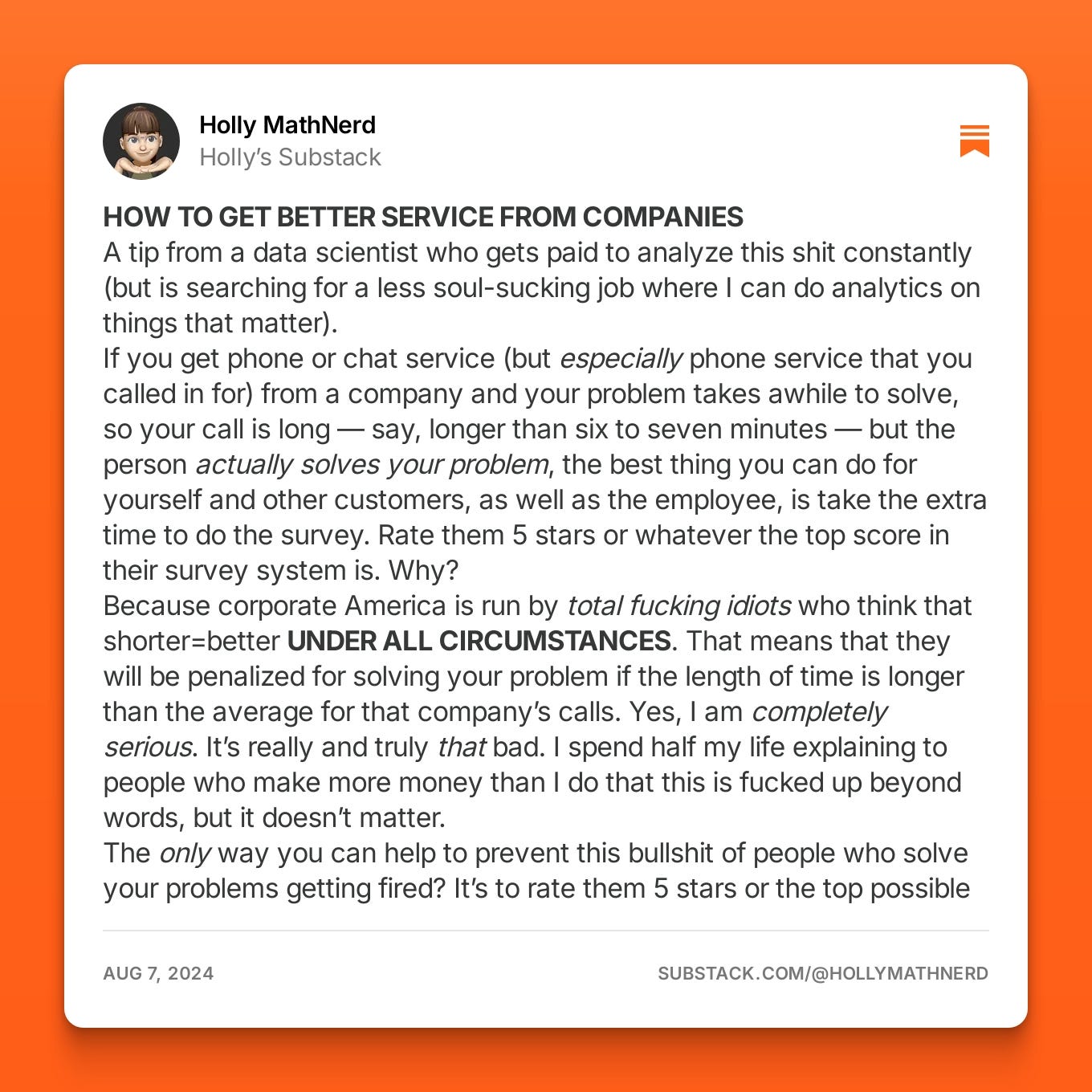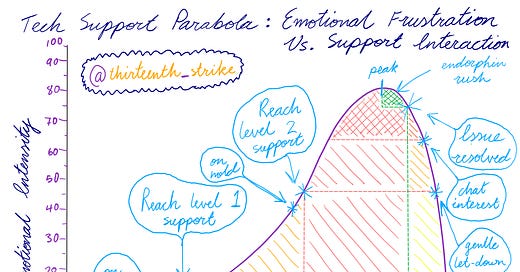Pre-blurb
This article was so generously inspired by both Holly MathNerd’s and Lisa Kuznak's Substack Notes (click on the images to see the Note):


Here’s a link to to the full thread.
Introduction—Intention and Goals
Have you ever needed to contact technical support for anything? Phone? Internet? Computer? How was your experience? On a scale from 0 to 100, how frustrated did you get? Did you blow up on the support person? Were you polite the whole time? Tech support can be a pretty thankless job. I worked this type of job for about four years. Overall, it wasn’t too bad. Though at times it could be hell.
My aim is to create a dynamic and experimental platform where I can explore and share innovative ideas. By decluttering my mental and physical space, I focus on one major project—my Substack, Thirteenth Strike. These articles, which I keep in the ‘Ideas Lab’ section, I delve into design thinking, systems thinking, and human-centred design to generate and develop creative solutions and innovative strategies. Though not always, sometimes I'll just be jotting down ideas that have struck me right in the noggin. My goal is to inspire and engage readers by presenting ideas in a clear, visual, and interactive manner, fostering a community of creative thinkers and problem-solvers.
The idea for this article came from a reflection on my experience working in tech support. Customers would often escalate emotionally through a predictable pattern, much like a parabola. This observation led me to consider how design thinking principles could be applied to improve tech support systems and manage customer expectations more effectively.
Visualising Emotional Intensity in Tech Support

The emotional journey customers experience during tech support interactions can be visualised as a parabola, representing the rise and fall of emotional intensity. The graph we’ll discuss helps illustrate this journey, aligning with the design thinking approach of empathising with users and addressing their needs creatively and effectively.
Understanding the Graph
X-Axis: Represents the different stages of tech support—initial contact, level 1 support, level 2 support, and resolution.
Y-Axis: Represents the emotional intensity of the customer.
The graph provides a dynamic and experimental visualisation of the emotional journey, inviting readers to explore and reflect on their own experiences and how they can relate to the stages depicted.
Starting the Journey—Initial Contact
When customers first contact tech support, their emotional intensity is relatively low. They have an issue, but they also have a “lifeline” (tech support), which helps keep their emotional intensity suppressed or in check. However, once the customer realises there will be work involved on their end, they begin to feel frustration—their emotional intensity increases. This is the shattering of the “magic bullet ideology.”
To keep tempers from flaring, support agents should be upfront about the expectations to ensure customers have realistic expectations about the process and their involvement in it. This initial interaction sets the tone for the rest of their support experience.
Proactive Communication
Instead of simply having the estimated wait time in the queue, add another metric for the estimated resolution time. This will depend on the options chosen and is presented before the call is answered. This sets the stage for the entire support interaction, managing expectations from the very beginning.
Escalating Engagement—Level 1 Support
As customers engage with level 1 support, their emotional intensity continues to rise. They might experience frustration when put on hold, or if the resolution isn’t immediate. It’s crucial at this stage to communicate effectively about what customers can expect.
Training Support Agents for Effective Communication
Support agents should be trained to clearly communicate the reasons behind delays or complex resolutions. If a solution isn’t immediate, agents need to explain why and what steps will follow. This management of expectations helps prevent the escalation of frustration.
Why Companies with a Monopoly Should Care
Erosion of Customer Trust and Loyalty
There are, whether we like it or not, and for various reasons, companies that hold monopolies within certain markets. Whether it’s a telecommunications company providing cell coverage where others can’t, or online shopping giants gobbling up all brick-and-mortar stores, they exist. There are times when these types of companies can become sloppy in certain aspects of their business. They might start cutting unnecessary corners just to help solidify their place at the top of the pile. A common area companies will cut costs in is support. Outsourcing is prolific. Where they’ll ship these business functions to countries where wages are low and they speak English as a second or even third language. This, in addition to bad support handling practices, leads to multiple issues.
These companies may feel secure at the top of the dog pile, but they should be cautious about neglecting customer satisfaction. Here’s what I reckon:
Customers may have no alternatives now, however, they would churn (move to another provider) the moment another pops up or becomes a viable alternative. All that lost trust and loyalty will come home to roost.
Regulatory and Legal Risks
Monopolistic companies who abuse their position in the market will oftentimes have extra regulatory eyes casting down upon them. This could lead to legal challenges and even be forced to make changes.
Technological Disruption
New technologies have a habit of disrupting monopolies, especially those that refuse to adapt and address customer pain points. A famous example of this is the downfall of Blockbuster and the rise of Netflix. Netflix effectively addressed two major customer pain points—the inconvenience of visiting a physical store to rent videos and the frustration with late fees.
The Rise of Competitors
As time goes on, the barrier for entry for up and coming competitors becomes lower. There are various reasons for this, one of the biggest is that the innovators have already spent the money on research and development. After some time, it becomes cheaper and easier for others to incorporate and/or reverse-engineer innovative elements.
Customer-Centred Resilience
Companies who are in tune with their customer base tend to be much more resilient and are able to adapt well to changing market conditions.
Climbing to the Peak—Level 2 Support
As customers are escalated to level 2 support, their emotional intensity increases sharply. This is the peak of frustration, often caused by unresolved issues and the belief that their problem is more significant or unique than it might be. This stage is compounded if customers rely on the service for work and start quoting SLAs (Service Level Agreements) and so on, instead of taking responsibility for their own actions.
Customers reach peak emotional intensity right before they realise their problem is likely to be solved. Once they realise this, their emotional intensity begins to taper.
Feedback Loops
Allow customers to give feedback at any point during the call. This feedback can be used to figure out what critical junctures are on the call and help highlight where the biggest pain points are. This real-time data can inform continuous improvements in the support process, helping to refine communication strategies and system designs.
Descending to Relief—Issue Resolved
After the issue is resolved, emotional intensity drops sharply. This is where the endorphin rush happens, and customers may start engaging in casual conversation. They might even express interest in chatting further or offer empty platitudes, feeling a sense of relief that their problem has been solved.
Critical Touchpoints and Metrics
Review and refine call centre metrics that may not align with customer satisfaction. For instance, focusing solely on call times without considering the quality of the interaction can lead to dissatisfaction. Redefining success metrics to include customer feedback on the overall experience ensures a more holistic approach to managing expectations.
Resolution—Post-Resolution Relaxation
Once their issue is resolved, all the empty platitudes start rolling in—there was never a doubt you’d solve their problem. This stage, where emotional intensity has dropped, is where the customer’s frustration is replaced by a sense of relief. At this point, it’s crucial to manage the conversation to a gentle close, ensuring the customer leaves the interaction on a positive note.
Recap and Reflections—Embracing Emotional Journeys
Managing expectations is crucial for a successful tech support interaction. Design thinking provides a structured approach to understanding and addressing customer emotions, leading to more effective and satisfying support experiences. By empathising with customers, defining the problem space, ideating solutions, and iterating based on feedback, we can create tech support systems that not only resolve issues but also enhance the overall customer experience.
For Companies Holding Monopolies
Don’t Fly Too Close to the Sun: Market dominance is not set in stone—companies should do well to remember that if they are aiming for longevity, it’s a game of long versus short-term thinking. Those companies who prioritise the people who they serve—their customers—ensuring satisfaction and innovation now, will help ensure they are around for the long haul.
This approach would ensure companies aren’t simply resting on their laurels. It encourages them to take an active role—not simply a reactive role, a proactive one. Anticipating problems and effectively dealing with them rather than ignoring them to the point where customer frustration reaches boiling point and their loyalty diminishes.
Reflect on experiences you’ve had with customer support—share them in the comments, and consider how these principles would have helped in your interactions.
What other ways do you think customer support interactions could be improved?
Do you think the principles outlined in this article could truly make a difference to improve both the process and outcomes?
That’s it for now,
As always,
Good luck,
Stay safe and,
Be well.
See ya!





It makes sense. My bigger frustration is the difference between level 1 and level 2. Level 1 rarely helps the problem and they always need to escalate. Worse, when I call back and can't jump into level 2 on a more complicated issue and have to go through the entire process again.